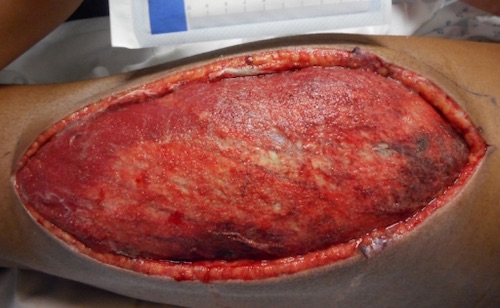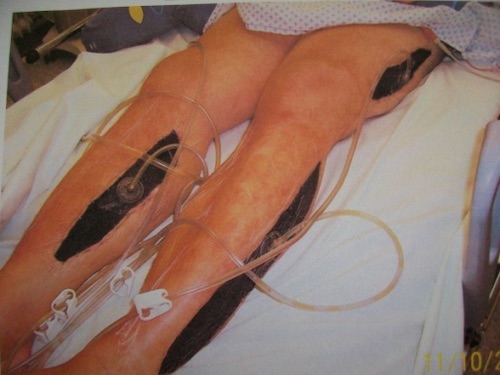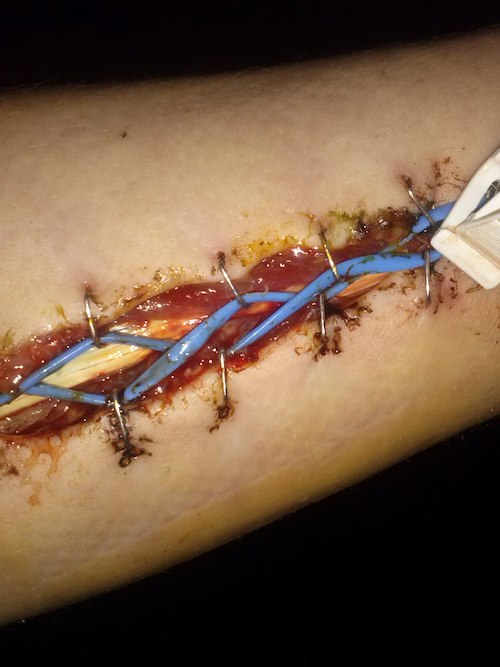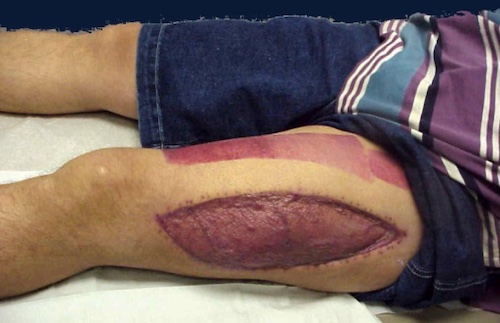Fasciotomy
Fasciotomy
David Ray Velez, MD
Table of Contents
Indications
Primarily Indicated for Compartment Syndrome – *See Compartment Syndrome
Prophylactic Fasciotomy Indications
- Ischemia > 6 Hours
- High Risk Injury:
- Combined Arterial/Venous Injury
- Complex Extremity Fractures
- Arterial or Venous Vascular Ligation
- Significant Crush Injury
Technique
General Principles
- Skin and Fascial Incisions Should Extend the Entire Length of the Compartment to Avoid Incomplete/Delayed Fasciotomy – Increased Risk of Muscle Necrosis, Infection, and Death
- All Compartments at Risk Should Be Opened
- Skin Incision Should Not Be Closed at the Initial Operation – Risk for Recurrent Compartment Syndrome
Upper Extremity Techniques
Lower Extremity Techniques

Fasciotomy Muscle Budging 1
Skin Closure
Approach/Timeline
- At the Initial Operation Wounds are Left Open and Either Dressed in Wet-to-Dry Dressings or Negative Pressure Wound Therapy
- Plan for Delayed Closure Techniques Once Swelling Has Resolved (After 3-7 Days)
- Ultimately Plan for Either Delayed Primary Closure or Split-Thickness Skin Graft (STSG)
Issues of Early Wound Closure
- Recurrent Compartment Syndrome from Continued Swelling
- Unable to Assess/Debride Nonviable Muscle and Tissue Which Can Lead to Infection
- Muscle Necrosis Occurs from the Inside-Out and May Require Further Debridement
- Skin Necrosis
Techniques for Delayed Closure Management
- Open with Wet-to-Dry Dressings
- Performed Until Ready for Skin Grafting
- Negative Pressure Wound Therapy
- Changed Every 3 Days Until Ready for Skin Grafting
- Gradual Suture Approximation
- Also Known as “Roman Sandals” or the “Shoelace Technique”
- Staples Placed Along the Skin Edges and Vessel Loops are Threaded in Crisscross Fashion
- Every 48 Hours the Vessel Loops are Tightened and the Skin Edges are Sutured at the Ends as Able
- Serially Tightened Until the Wound is Fully Closed (Generally After 5-21 Days)
- Dynamic Dermatotraction and Static Tension Devices
- Numerous Devices Developed but Mostly Confined to Single-Center Experiences
- Less Popular
Leaving Open and Healing by Secondary Intention Has Been Abandoned – High Risk of Muscle Necrosis, Infection, and Sepsis (May Consider for Wounds that Have Failed Other Approaches Due to Infection or Dehiscence)

WVAC Closure 2

“Shoelace” Closure 3

STSG 4
References
- Felte R, Gallagher KE, Tinkoff GH, Cipolle M. A Case Review Series of Christiana Care Health System’s Experience with Negative Pressure Wound Therapy Instillation. Cureus. 2016 Nov 7;8(11):e865. (License: CC BY-3.0)
- Saugel B, Umgelter A, Martin F, Phillip V, Schmid RM, Huber W. Systemic Capillary Leak Syndrome associated with hypovolemic shock and compartment syndrome. Use of transpulmonary thermodilution technique for volume management. Scand J Trauma Resusc Emerg Med. 2010 Jul 5;18:38. (License: CC BY-2.0)
- Pomert T. Wikimedia Commons. (License: CC BY-SA-4.0)
- Kanlic EM, Pinski SE, Verwiebe EG, Saller J, Smith WR. Acute morbidity and complications of thigh compartment syndrome: A report of 26 cases. Patient Saf Surg. 2010 Aug 19;4(1):13. (License: CC BY-2.0)
